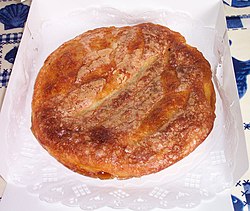Kouign-amann

Kouign amann pastry from Douarnenez
|
|
| Type | Cake |
|---|---|
| Place of origin | Brittany |
| Region or state | Douarnenez, Finistère |
| Main ingredients | Dough, butter, sugar |
| |
|
Kouign-amann (pronounced [ˌkwiɲˈamɑ̃nː], pl. kouignoù-amann) is a Breton cake. It is a round crusty cake, originally made with bread dough (nowadays sometimes viennoiserie dough), containing layers of butter and sugar folded in, similar in fashion to puff pastry albeit with fewer layers. The resulting cake is slowly baked until the butter puffs up the dough (resulting in the layered aspect of it) and the sugar caramelizes. The effect is similar to a muffin-shaped, caramelized croissant.
Kouign-amann is a speciality of the town of Douarnenez in Finistère, Brittany, where it originated around 1860. The invention is attributed to Yves-René Scordia (1828-1878).
The strict recipe of Douarnenez requires a ratio of 40 percent dough, 30 percent butter, and 30 percent sugar. The more traditional method of serving is as slices from a large cake, although recently especially in North America, individual cupcake sized pastries are becoming more popular.
The name derives from the Breton language words for cake (kouign) and butter (amann). The Welsh equivalent is the etymologically identical cacan menyn, literally 'cake (of) butter'.
In 2014, the BBC aired an episode of The Great British Bake Off featuring the kouign amann. In 2015, it had also increased in popularity in the United States with notable bakeries in New York, Washington D.C., Boston and San Francisco highlighting the pastry. The Dominique Ansel Bakery, home of the trendy cronut, sells a version of kouign amann called the DKA.
...
Wikipedia
